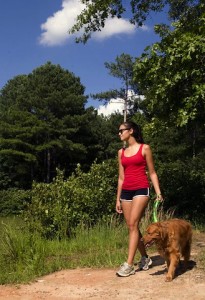“Fitness isn’t easy and it’s not supposed to be: anyone telling you otherwise is lying to you. Activity, on the other hand, should be really easy. Knowing the difference and not confusing the two is important, but the key is also knowing that you need both in a health and wellness program.”
In a day and age where high-intensity exercise arguably reigns supreme, we have to be careful not to forget the importance of low-intensity (non-exercise) physical activity (NEPA) for multiple health, body composition, and fitness benefits. It has bothered me for quite a while that most people exercising for health reasons focus so much on moderate intensity continuous exercise. If you consider that almost all of the public health recommendations for exercise prescription, including those for both healthy and chronically ill populations, recommend at least 150 minutes of moderate to vigorous intensity – around the lactate or anaerobic threshold – continuous exercise and/or physical activity (1), it’s no wonder that this is happening. Although we can debate the merits of interval type versus continuous exercise for hours on end, what has been increasingly clear is that exercise, however you define it or perform it, is not enough for promoting optimal health and longevity.
As an aside, I find it very strange that the moderate intensity steady state (MISS) recommendations that are prevalent throughout many published guidelines are based on the ‘endurance’ model of training; however, when you look at how many of the world’s top endurance athletes train, they use primarily a polarized model (2,3). This model minimizes the time spent doing MISS exercise, maximizes the volume of low intensity activity/exercise, and optimizes the remainder of training doing high-intensity work (intervals and/or strength training). If these athletes don’t spend much time at lactate threshold/moderate intensities during training, it is inconceivable to me why we would do this for the rest of us (particularly when there is much greater benefit associated with a well designed strength/power training program). Not to say that the ‘aerobic’ system is not important, but that the way we typically think to train for it is somewhat flawed (more on this another time).
Back to the guidelines for you and I: the ‘non-athletes’. Assuming we accept that 150 minutes of moderate to vigorous intensity exercise is an ideal weekly goal, does it matter how we get that volume of work done? The short answer is: yes (the long answer in Part 3), but keep in mind that that 150 minutes is based on an assumption of a ‘normal’ amount of NEPA – that is, the activity that is outside of exercise time (4). In this modern technological era, we are spending more time sitting, and less and less time being active; and this reduction has a major impact on our health, regardless of the actual ‘exercise’ we are doing (4). Let’s be clear here: exercise alone is not good enough to optimally maintain health and longevity as we age.
Increases in sedentary activity are negatively associated with health and longevity, regardless of the amount of exercise someone does. The bottom line is: the more you sit, the less healthy you’ll be, even if you’re engaged in a formal exercise program. A very cool, large study examining this discrepancy was published in January 2014 (5). Researchers from Sweden examined over 4000 60 year olds and compared their cardiovascular health/risk and 12 year mortality rates with their levels of NEPA and exercise habits. Participants were grouped into high, moderate, and low levels of NEPA and each group further divided into those who exercise and those who don’t. In terms of the risks of developing combined diabetes, hypertension, and obesity (metabolic syndrome), those who exercise, but had low levels of NEPA had a moderate reduction in risk. This reduction was similar to the group who did not exercise but had high levels of NEPA. The benefit to the group who exercised and had high levels of NEPA was exponential in that their risk of developing metabolic syndrome was less than half that of the other groups (5). In addition, when tracked over a 12 year follow-up period, those who exercised and were active had a reduction in mortality around double that of the groups who did one or the other. These findings are not unique and have been shown in various populations (6,7). Simply put: those who are physical active and exercise live longer and have less risk of chronic disease.
Why is this important? For most people, beginning an exercise program actually reduces the amount of NEPA performed (8). Perhaps people think (because this is what they’ve been told) that exercise alone is good enough. Even many marathoners are couch potatoes when not exercising (9). The message is clear: we all need to increase our low intensity physical activity over and above our well-designed exercise bouts. The good news about this is that we simply need to be active and can choose activities of our individual liking – it doesn’t need to be complicated. The trick, though, is to fit strategies to enhance our NEPA and reduce our sitting time into our occupationally and recreationally sedentary daily lives. Part two of this article will examine the literature on this and present strategies to do just that.
References:
(1) American College of Sports Medicine. ACSM’s Guidelines for Exercise Testing and Prescription, 9th Ed. 2014. Lippincott Williams and Wilkins; Baltimore, MD.
(2) Neal et al. Six weeks of a polarized training-intensity distribution leads to greater physiological and performance adaptations than a threshold model in trained cyclists. J Appl Physiol. 2013;114:461.
(3) Seiler et al. Quantifying training intensity distribution in elite endurance athletes: is there evidence for an “optimal” distribution? Scand J Med Sci Sports. 2006;16:49.
(4) Tudor-Locke et al. Steps to preventing Type 2 diabetes: exercise, walk more, or sit less? Frontiers in Endocrinology. 2012;3:142.
(5) Ekblom-Bak et al. The importance of non-exercise physical activity for cardiovascular health and longevity. Br J Sports Med. 2014;48:233.
(6) Manson et al. Walking compared with vigorous exercise for the prevention of cardiovascular events in women. N Engl J Med. 2002;347:716.
(7) Besson et al. Relationship between subdomains of total physical activity and mortality. Med Sci Sports Exerc. 2008;40:1909.
(8) Kozey-Keadle et al. Changes in sedentary time and physical activity in response to an exercise training and/or lifestyle intervention. J Phys Act Health. 2013 (In press).
(9) Whitfield et al. Sedentary and active: self-reported sitting time among marathon and half-marathon participants. J Phys Act Health. 2014;11:165.










